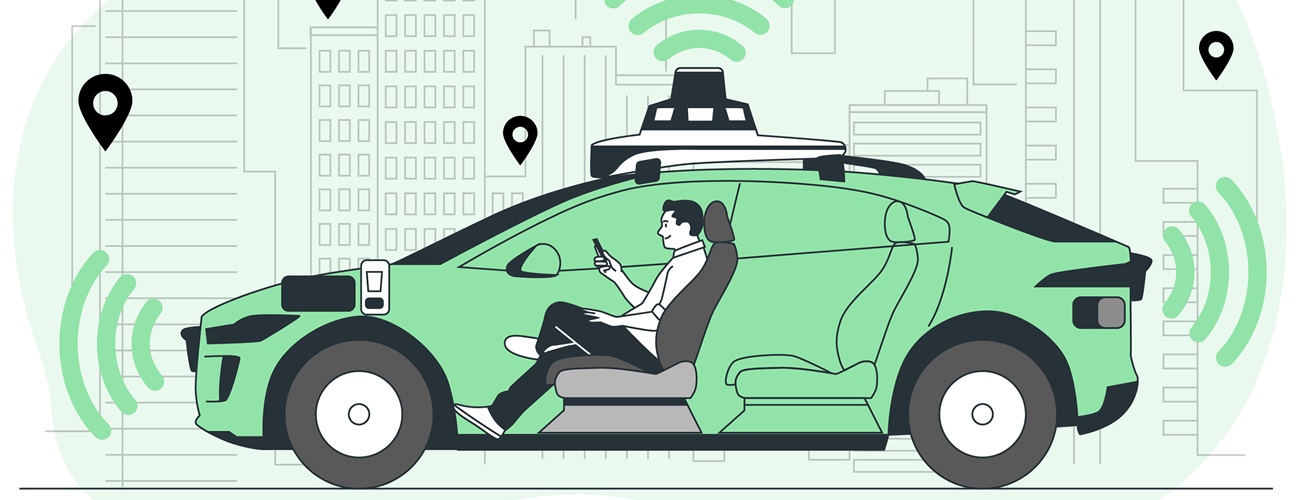Self-driving Automobiles overview
Self-Driving Cars refer to autonomous vehicles that can drive themselves. Firms such as Tesla, Waymo, and Cruise are experimenting with this emerging technology, and it is projected that fully autonomous cars (Level 5) will be available for the public within a few years. The development of AVs comes in five categories of autonomy. They are ranked from Level 0 (no automation) up to Level 5, that is, fully automated. Till date, as of 2024, Level 3 and Level 4 AVs are allowed to operate within approved zones only.
The autonomous car is designed with various components such as artificial intelligence, radar, cameras, and sensors. It self-navigates using real-time data and high-definition maps, which include much more detail than standard GPS maps such as traffic signals, road layout, and other infrastructure. Also, vehicles must be able to communicate with each other and with the infrastructure, like traffic lights, using Vehicle-to-Everything (V2X) communication protocols, which is an emerging area of software development for autonomous vehicles.
However, as with any new technology, so with Self-Driving cars there come numerous technological, regulatory, and societal challenges as will be discussed below.
Core Components of Autonomous Vehicles:
Sophisticated software and algorithms are a must for Self-Driving Cars, along with perception, decision-making, and control.
- Perception Systems: A perception system helps the car to see and know what is around it. The data from sensors such as cameras, LiDAR, radar, and ultrasonic sensors are gathered. It is processed through software that allows identification of objects, road signs, lane markings, pedestrians, cyclists, other cars, and even potential obstacles. Deep learning plays a great role in how well a car identifies and categorizes objects.
- Decision-making Systems: These decision-making software programs gather data from the perception system for the analysis process and decide upon which actions should be suited by the vehicle according to the given environment. These take real-time decisions regarding the acceleration, braking, turning, or changing lane. The algorithms for this purpose rely on environmental models, and commonly used techniques often include reinforcement learning techniques that enable the system to learn from their experience and eventually improve the processes of decision making over time.
- Control Systems: This is the software that controls the car’s hardware directly and its movement. It sends commands to the steering, braking, and throttle in following the decisions of the decision-making algorithms. The system ensures that the vehicle can do maneuvers accurately in a smooth and safe manner even when the traffic condition is complex and changing.
Challenges and Hurdles in the Safe Integration of Self-Driving cars into mainstream transportation:
Safety& Testing: Level 5, or fully autonomous vehicles must comply with regulations regarding safety standards, includingthe AI system’s correct working behavior over various scenarios.
Liability and Insurance: In case of any accident involving the driverless vehicle, who will be liable? Is it the person who manufactured the vehicle or the one who constructed the software or the owner of the vehicle? Insurance policies must also take into consideration the following unique risks associated with self-driving automobiles: cyber issues and glitches in the AI system.
Privacy Issues: The large amounts of data collected by autonomous vehicles raise the question of privacy concerns.
Traffic Laws, Regulations& Infrastructure: Current traffic laws cater to human drivers. Speed limits, liability, right of way, traffic lights, stop signs, etc., need to be changed to accommodate autonomous driving. Public infrastructure would also need to be updated to accommodate AVs.Because autonomous cars depend on detailed road maps that give specific data about streets, traffic lights, and other structures, these would also need to be put in place.
Ethical and Moral Considerations: Considering the ethics and morality of self-driving cars means dealing with the tough decisions in “trolley problem” scenarios where the car has to choose who to save.
We also need to make sure AI systems are fair and don’t single out groups like people walking or biking. What’s more, governments should come up with rules to register these cars, which should change based on how self-driving they are. For cars that still need some human control, rules should spell out what kind of license and training drivers need.
Harmony & Coordination between authorities and countries: International standards may need to be set up so that there is consistency in regulation for self-driving vehicles. Local regulations would also need to be harmonized. Governments, legal experts and industry leaders will need to work together to create comprehensive frameworks for safety, liability, privacy, ethics and infrastructure to get autonomous vehicles on public roads safely and fairly.
Conclusion
Building software for self-driving cars brings together the latest tech in AI, machine learning, robotics and sensor fusion. We’ve made big strides but there’s still work to be done on safety, reliability and making ethical decisions.
If we can tackle these issues, self-driving cars could shake up how we get around and live our lives in big ways making things safer, easier, and more accessible for folks all over the globe.




